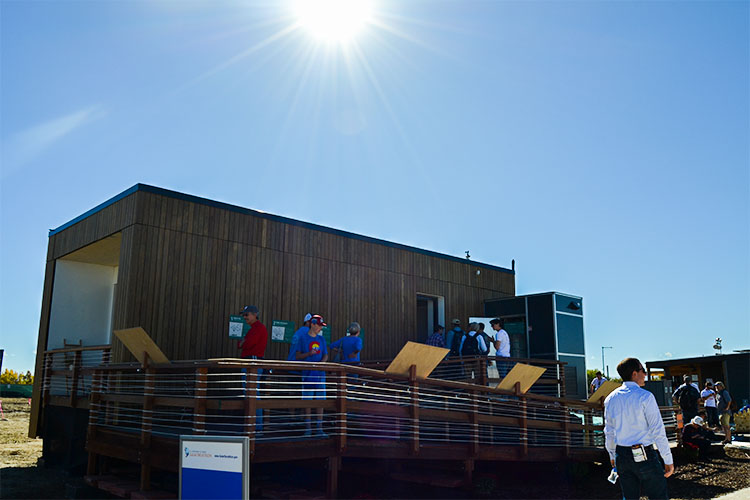
One of the water and energy optimized houses on display at the competition. photo by Logan Cecil
Teams from around the world assemble to show off their environmentally conscious houses.
With growing concerns about the environment, many companies are beginning to invest in sustainable and environmentally conscious buildings and houses. Hoping to spur the growth of this movement, the United States Department of Energy hosted the biennial Solar Decathlon, a competition encouraging innovative housing design in Denver this year from Thursday, Oct. 5 through Sunday, Oct. 15. In attendance were multiple volunteers from the TJ Robotics program.
Ten collegiate level teams competed, with a goal of blending design and clean energy production with innovation, market potential, and resource efficiency. These aspects of the competition require the collaboration of multiple academic disciplines, including engineering, architecture, interior design, marketability, and communications. The teams also have to undergo a very selective application process to take part in the event, having to demonstrate their superior understanding of the four criteria that need to be submitted in their application: a design that allows for an entirely solar-powered house, sufficient fundraising and funding, supporting the project through well-integrated curricula, and assembling a team to carry the project through to completion. Having all of these students working and collaborating on a single project can be complicated, but it is intended to simulate a real-world workplace and give the competitors skills they can use in their future careers.
One of the overshadowed aspects of the competition are the studies that go into the target audience’s needs from a house. In an interview, Volunteer Coordinator James Harshman mentioned how three of the teams, Team Daytona Beach, Las Vegas, and Northwestern, focused on the “baby-boomers” and what they needed in a house and what they found appealing in the design. He said, “They wanted to design a house where a couple could move in and as they progress in years and their needs change, whether they need wider doorways for a wheelchair or to have a live-in assistant come into the house, they could make these changes, and they had to take all of these thoughts into account before they even started their designs.” To further increase the complexity, the schools had to base their designs on the areas that they were from, taking things such as wildfires and flooding into consideration. The UC Davis house, for instance, was very focused on water conservation, hoping to address the drought in California. It is a multi-faceted competition, and its many challenges require a huge effort from the students to meet their deadlines.
Northwestern, one of the three schools that focused on the “baby-boomer” audience, discovered that people in this generation typically don’t like the way solar panels look, which could be a problem for an event centered around solar energy. Northwestern student Manasi Kaushik, a journalism major hoping to become an environmental journalist, was involved with communications and played a key role in spreading the message of sustainability to a younger audience through social media. In order to appeal to these potential buyers, they made their solar panels “roof-integrated,” meaning they are a part of the roof and don’t stick out. The focus didn’t stop there, Kaushik mentioned, “the colors that we used are colors that baby-boomers like, creams and light-blues. Our TV is part of the wall because they don’t like it being the focus of attention. The idea was to build a home that was sustainable, but without compromise. To them, aesthetic value matters more than sustainability, so that’s what we’re selling.”
Hoping to address the bigger picture, this event aimed to inspire a focus on the environment globally and hopefully spur a change in the way we collectively think about our energy and water usage. Ending on a powerful note, Kaushik stated “The idea is that everybody starts becoming more conscious about their housing and sustainability because we need to start thinking about the future generations. If we don’t, there might not be any future generations.”